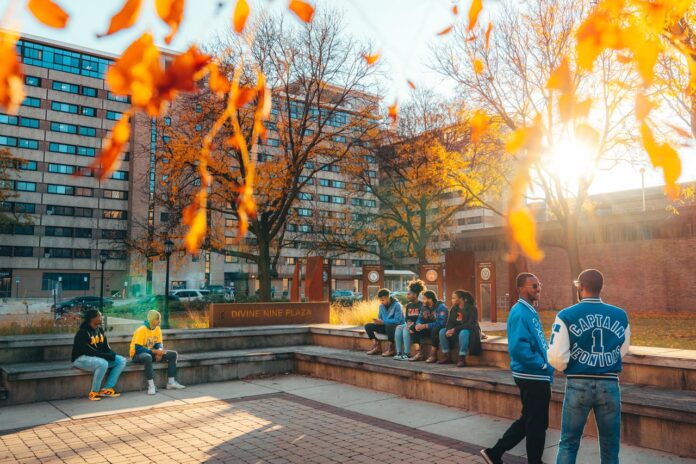“Our voices do not matter.” This is a response you might hear if you ask a student about their experience as a National Pan-Hellenic Council (NPHC) member at a predominantly white institution (PWI) without visible artifacts or a feeling of investment from the institution. Since 1946, much of NPHC history at the University of Wisconsin-Madison has not been archived, and it was the source of many difficulties in engaging with alumni and current students alike. NPHC was a minimally highlighted student experience. They dealt with many circumstances of isolation – it was not uncommon to be the only BIPOC student in their classroom or space – and yet they persevered through advocacy and resistance for many years. As fraternity/sorority advisors (FSAs), we have the opportunity to create change at our institutions to help elevate the voices of those from marginalized groups. It is the role of the FSA to support the growth of better communities by creating a space where students who may not find a sense of belonging elsewhere at a large PWI can do so in the NPHC community. We must be bold enough to think differently and help our institutions understand the importance of Black Greek-Lettered Organizations (BGLOs).
The lack of an investment from the institution caused NPHC members at UW-Madison to issue demands to reach their goals of further supporting their organizations. In 2019, the institution was given the opportunity to make a difference and was tasked to further understand the need to elevate the voices of Black fraternity/sorority members. A variety of stakeholders were engaged in this process to inform this vision, including an external review board, a student-led inclusion coalition, and a working group made up of NPHC and Multicultural Greek Council (MGC) members. The recommendations of the NPHC/MGC working group were followed, which focused on creating a visible space on campus for marginalized organizations, which later became the Divine Nine Plaza.
Our staff recognizes every institution’s NPHC community has different needs, and we acknowledge that continued advocacy is needed to support the organizations and their members to build a sense of belonging on any campus. As we continue to reflect on the past two years of building a Divine Nine Plaza, we hope our lessons learned and recommendations support the knowledge and ability of FSAs across the country to advocate for and to create spaces on campus that represent BGLOs. Below you will find our lessons learned and recommendations to further support FSAs on this topic.
Listening to Understand the Experiences of NPHC Students
As we navigated various demands, we knew that student voices were the utmost priority to help create visibility. We centered their voices through the listening process to understand their experiences on campus. Focus groups included members of NPHC to ensure we were hearing and understanding their experiences and willing to move forward with their input through every step of the project. Advocacy from the Fraternity & Sorority Life team was an important aspect of the focus group to get upper administration engaged in beginning the conversations about creating a Divine Nine Plaza. The department’s priority was to establish a visible artifact that highlights the history of NPHC on campus. Many questions arose about who should be involved, where the plots would be located on campus, how to get the funding, and the long-term positive impacts of the project.
Creating a Team
The real work began when we had to create a team that would see this project through. Collaboration was important as we navigated complex university structures, so we had to be strategic in considering the departments that could support such a large project. Representation from multiple departments brought different perspectives, ideas, and viewpoints. There was one representative from each of the following departments/groups: the Division of Student Affairs, NPHC students, Student Affairs Advancement, Wisconsin Alumni Association, Facilities Planning & Management team, and an NPHC alum. Due to the various moving parts and the goal to finish the project in less than two years, the team met biweekly. With six to ten committee members present regularly, they were given tasks to complete between meetings and to report back to the large group.
The other stakeholders we needed on our team were the national headquarters. Each NPHC organization is a business, and to use any of their crests or mottos required that we meet with constituents to discuss legal matters around copyright. They were our best supporters in providing insight into the founding of their organizations and supported the project by submitting the necessary legal paperwork to use their symbols on campus property. We suggest that national headquarters are a necessary stakeholder in developing NPHC plots. Provide them with an overview of the project so they can invest in and support the students and alumni from the designated local chapters.
It is also important to consider who is immediately impacted in the vicinity of your project location. Neighbors from surrounding buildings were curious to understand the effects it would have on them, which meant we needed to be transparent with the construction timeline and traffic flow in the area. We encourage FSAs to think about who will be on their team to help create NPHC plots and who needs to be informed or updated for various reasons.
Funding & Alumni Engagement
Our team had to be creative when it came to marketing on how to support the project financially. We engaged the entire fraternity/sorority community with various fundraisers to raise awareness, both financially and about NPHC. Students from across all councils participated to support the project. Through trial and error, we recognized there was a lack of investment from NPHC alumni because most of them never felt invested in by the institution. It was then realized the amazing asset we had with the NPHC alum representative on our committee to support outreach and direct conversations with constituents. Personal narratives and the importance of the plaza were key to getting engagement from alumni.
We created a tier system for donors to get their names engraved on the monuments, which provided an enticing incentive. UW-Madison NPHC alum or active members who donated $1,000 would have their names engraved directly on their organization’s monument. Major donors (giving $25,000 or more) earned their name closest to the entrance of the plaza. Seeing this success, the institution and the Division of Student Affairs invested in the project. Recognizing that not every donor can provide immediate funds, we worked with our student affairs advancement team to create payment plans throughout the next two years. Donors were recognized as either individual names, family names, chapter lines, or honoring someone on their behalf. It was also important to donors that only UW-Madison NPHC alumni would be recognized on a monument. This exclusivity and opportunity to contribute to a lasting landmark on campus, in turn, proved successful in funding the overall project.
Purpose of the Space
It is important to discuss with students what they hope to use the space for. Is it for new member presentations, any large-scale events, individual chapter usage, or a formalized space to honor their organizations? We did not prepare for how NPHC would utilize the space. As the project completed, we quickly learned organizations wanted to use the space for varying initiatives.
Any new space on campus comes with the excitement of using it for various reasons. Many campus departments and non-NPHC organizations were ready to use this space. Our department stepped in to navigate the complexity of why the space is meant for NPHC, to educate the community on the significance of plots, and why it is crucial not to use the space without partnering or collaborating with NPHC.
One main problem that came about was the risk management and approval process to use a public outdoor space on campus. We partnered with our Campus Event Services Office to make the space an exclusive location only for NPHC, which meant our office had to implement a new reservation process for NPHC organizations to request the space for programs like a chapter BBQ or a new member presentation. FSAs should consider and be prepared to have conversations on what the space will be utilized for during the mockup phase and before construction begins.
Overall Impact on Campus
Our team knew this plaza would amplify the visibility of NPHC and elevate the members’ sense of belonging, but we did not realize the impact it would have on the greater community and campus. After completion of the project in May 2022, our department learned the plaza would be included in every admissions tour for incoming and transfer students, which allowed for more students and families to understand the impact and importance of NPHC at UW-Madison. Many media outlets began to reach out to speak with students, to hear their stories, and to highlight the 75 years of NPHC history on campus, which had not previously been widely acknowledged or documented. Campus departments began to recognize NPHC and reach out to collaborate, which further increased their visibility on campus.
Fraternity & Sorority Life continues to set expectations and educate campus departments and stakeholders about the importance of NPHC, including that they should not be utilized as only a performance for their benefit. Institutions or campus partners should recognize that these organizations should not be tokenized, and the NPHC members are more than just a stroll performance at a department’s event. Intentional relationships have been built with campus partners to further challenge the use of the Divine Nine Plaza and why it is important to be an exclusive space for NPHC. NPHC provides a home for students who want to belong on campus and who want to make meaningful impacts through service on and off campus.
There is a lot to be learned from UW-Madison’s experiences of building an NPHC plaza. Our recommendations are a starting point to elevate the voices of members in Black Greek-Lettered Organizations. We must continue to advocate for spaces that represent NPHC history, create a sense of belonging for Black students, invest in inclusion, and educate the community on the impacts the Divine Nine has made globally.
About the author
Cristian McGough (he/him/él) currently serves as the Fraternity & Sorority Life Specialist in the Office of Fraternity & Sorority Life at University of Wisconsin – Madison, where he supports the Multicultural Greek Council and National Pan-Hellenic Council operations. Cristian earned his B.A. in Human Development from California State University San Marcos, where he joined Sigma Chi. Cristian attended the University of San Diego for his M.A. in Higher Education Leadership studies. Through his experiences, he has found a passion for supporting and advocating further visibility to underrepresented communities.


